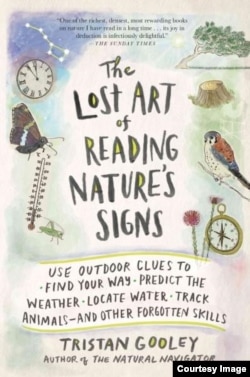Nature is sending us messages all the time, but most of us can’t read them. Tristan Gooley says he can.
The British explorer has led expeditions on five continents, climbed mountains, and studied navigation methods in remote regions on Earth. He also founded a school for natural navigation to help people decode these messages. And in his new book, "The Lost Art of Reading Nature’s Signs", Gooley shares more than 850 different clues from nature that can help people find their way, predict the weather and get more out of their time outdoors.
Nature's compass
For example, figuring out which way is north, without a compass.
“One of the first things to look for is the sun, if it’s out,” Gooley says. “If you’re north of the tropics, then the sun is due south in the middle of the day. That’s the best place to start.”
Trees can be helpful in navigation because their shape and color can indicate compass directions. “Trees grow bigger, more bushy, there is just more tree on the southern side, because that’s the side that gets most of the light.” That's the same reason leaves are smaller and lighter in color on the south side than one the north side, when they're more in the shade.
Predicting weather
Nature also provides clues that can help predict weather.
“I think a lot of people are still familiar with the most popular weather law, ‘Red sky at night, sailors delight,’” he says. “There is a lot of truth in that. Weather comes from the west and we know the sun sets in the west part of the sky. If you see red sky at night, what this is saying is the atmosphere is clear to the west, it’s clear in the direction the weather is coming from,” he says.
Gooley says there is nothing new about reading nature’s signs, but today, people tend to ignore them. He points to the sky as an example.
“Each cloud is actually trying to tell us something about what’s going on the next day. If we see a halo around the sun, that’s telling us that a certain type of clouds, known as cirrostratus, is out there. That’s one of the clouds that we see just before bad weather approaches. It doesn’t mean bad weather is definitely coming, but it’s a strong clue to be observed and look for other ones.”
You can scan the horizon for more clues. No matter how clear the sky is, Gooley points out, the horizon is never blue. There is always a white hue. Pure white along the horizon signals the air is clean. When it’s off-white, this is a clue that there are impurities in the air. When the color is grey, it means the air contains dust, soot, salt or acid droplets.
Animal awareness
The author notes that even animals as far from the sky as you can get pay attention to nature's messages. "What’s really interesting is fish are also finely tuned to their environment. When a cloud goes over the sun, they know that that’s going to lead to certain insects falling out of the sky when the temperature falls.”
And the moon has an impact, as well. “What we found that might be seen as folklore and people might not believe it, is the amount of moon we see will be directly related to the behavior of the fish. If you see a full moon, which is tied to what’s known as Spring Tide, fish are more active at that time,” says Gooley.
With the arrival of spring in the northern hemisphere, this could be the perfect time to be more observant, try to pick up on cues and clues, and read nature’s open book that is all around us.










